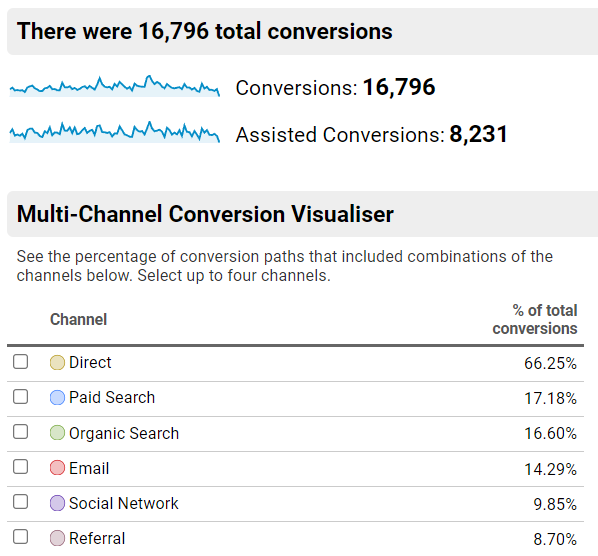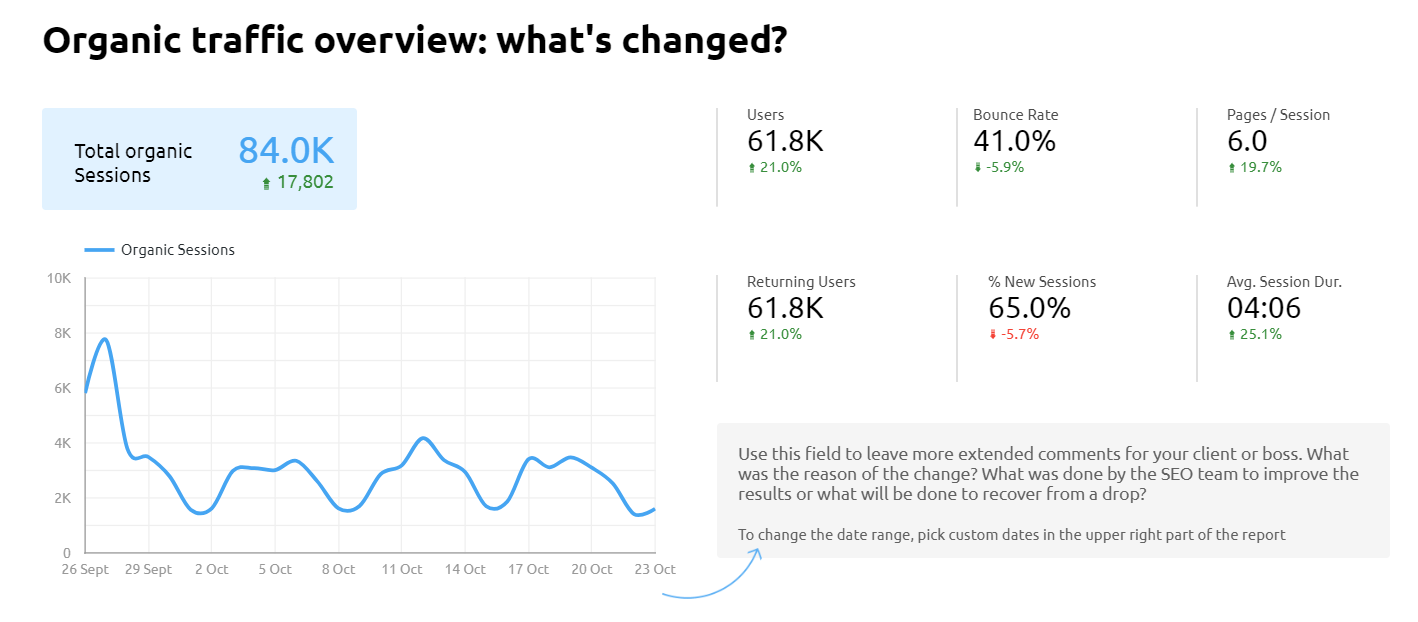If you’re an in-house marketer, you might be tasked with reporting on SEO performance to several different groups of stakeholders. While reporting can be time-consuming, it’s also an essential part of the SEO lifecycle on every level.
You need to understand which parts of your strategy are performing well on a granular level and which might need some improvement, and various stakeholders will need to know not only the top line stats and facts, but will also often require accompanying insight so that the information is meaningful to them too.
Getting your SEO services reporting right can be tricky at the best of times, and never more so than when updating the C-suite (CEOs, CFOs, CMOs and CTOs etc.) with the information they need to know. With such a highly measurable marketing channel as SEO, there are hundreds, if not thousands, of metrics that you could potentially report on, but too much information can be worse than not enough.
When reporting to the C-suite specifically, you’ll need to include only the data, insight and context that is meaningful to them in their role, which will enable them to make future business decisions and strategy based on what you provide.
Getting buy in for SEO in the first place is one thing, but ensuring that the company board/executives understand the value of the channel on an ongoing basis through your reports is quite another.
In this article, we look at some of the challenges that SEO professionals face with reporting SEO to the C-suite and how to overcome them.
Determining the key metrics that matter to your C-suite
One of the main issues when reporting on SEO to the C-suite is that not everyone will have the same level of existing knowledge and understanding of SEO and other digital marketing channels.
They work together towards business goals but the kind of results that make you happy as a marketing professional might not have the same impact on them. Asking them what they want to know doesn’t always work either. If they don’t have a good working knowledge of SEO, they might not realise the impact potential that the channel has, so it’s often just down to you to discover the most important information to communicate in your reports and it might take a few tweaks before you get to a place where everyone is getting what they need from you.
While the nature of your business will play a major role in the metrics that really matter in your individual situation, we’ve summarised some key areas that can be very beneficial to report on to business executives, including:
1. The revenue driven by SEO
The ROI (Return On Investment) of SEO is something that is always going to be the most important consideration for some of the C-suite.
How the revenue driven by organic traffic (Direct as well as Assisted Conversions) compares to the money outlaid on this channel activity is of course an essential area to report on.
This information obviously needs to be communicated alongside a commentary and with wider context of the strategy, as every SEO knows that results don’t come overnight. It’s not realistic to expect organic revenue to increase from day one of an SEO strategy being implemented – but managing expectations and having a growth forecast in your report that you can start to measure revenue against can be a good way to show that progress is being made from the first few months onwards.
2. The impact of SEO on brand awareness and online visibility
While organic revenue is usually the most important thing to the C-suite, it isn’t the only benefit of SEO by any stretch of the imagination.
Ensuring that you also report on metrics that show brand visibility and awareness growth can also show some of the additional value that SEO adds to the marketing mix.
Frustratingly, brand awareness isn’t as straightforward to measure as many aspects of digital marketing, but some of the areas to track that tend to correlate with more people knowing about the brand include:
- Look in Google Search Console at the ‘brand’ keywords being used. The number of different keywords being used as well as the impressions and clicks produced by these searches can be a good indicator of more people taking an active interest in your brand.
- Look out for direct traffic growth shown in your analytics platform. This can show if the number of people going directly to your site via their browser rather than using a search or clicking on an add etc. is increasing over time alongside your SEO activity.
- Look at referral traffic too. If more people are clicking through from links on other sites then this often correlates with more people being aware of and trusting your brand enough to do so.
- Check the link profile of your site for new links earned that you haven’t specifically targeted as part of your SEO or Digital PR People deciding to link to your site and mentioning your brand even if you haven’t had any contact with them can be a good indication that your influence and authority is growing. Of course, these types of links gained can also be a performance indicator for organic search and content marketing too, if they found the content that they linked to through using a search engine.
- You can also look at Google Trends to see if there has been an uplift in searches
3. How the SEO strategy is engaging your target audience(s)
It’s important to develop a SEO strategy that takes the full user journey into account and how their searches change over time as their intent also evolves.
Including information about performance broken down by journey stage (search intent) in your reports can be a great way to highlight the importance of each step along the path towards conversion and the role that plays in the eventual return.
You can do this by grouping same-stage content in your analytics platform to see how searchers are engaging with it and whether it’s successfully moving people onto the next stage. By segmenting organic traffic into groups that reflect your audience personas (using Google Analytics, as an example), you can analyse and report on their on-site behaviour, as well as looking at attribution and the role that organic search plays along with other channels, all within the context of the people you’re trying to reach because they are the most likely to convert.
C-suite executives don’t just care about current performance, they are also always looking into ways to grow the business in the future and other opportunities to take things forward.
Ensuring that your reporting is segmented can not only show performance for your current target, it can also give early warnings if your market evolves or responds to trends.

4. How SEO is working with the other marketing channels
SEO has often lived in its own silo in many businesses, but the reality is that it can play a huge role in multiple channels and contribute to the wider success of the business.
As an SEO professional, reporting on this can help back up the importance of SEO in the whole mix, and illustrate how working with a joined-up strategy across channels can give a better ROI than if they all work in isolation.
Some of the areas you can report on include:
- How SEO and PPC are working together to dominate top positions for key search terms (you can also show efficiencies made between the two channels to help demonstrate improving ROI)
- Any backlinks gained from SEO plans that include digital PR activity
- How PR activity incorporates organic optimisation e.g. an optimised landing page for a campaign report
- How content created has delivered SEO results alongside social media engagement and email campaign conversions
Other elements to consider including in your C-suite reports
Most regular SEO reports will also need to include a very top line overview things including:
- The SEO activity carried out since the last report and what the objectives for this was/is (and how this related to business goals)
- Results of this recent activity
- Results that continue to come in from previous activity (reiterating that SEO is a long-term strategy that continues to add value and snowball over time)
- Technical SEO progress that has been made e.g. site speed improvements made (and the impact this has had on results)
- Recommendations for future SEO activity and how that relates to the company’s goals
Platforms or tools used in SEO C-suite reporting
The best format of your SEO reports for the C-suite can be difficult to pin down because you’re trying to please several different people with different views on what is most important.
However, it’s always essential that any data should be presented along with insight or commentary so that everything in it ties back to the bigger picture of the success of the business, rather than being taken in isolation.
A great tool for this is Google Looker Studio (GLS) – previousl “Data Studio”, which enables you to take data from lots of different sources and add a combination of results visuals and text, along with things like presentation slides if you need them to give further explanation.
It provides elements of automation (many reports will use live data and update automatically) but always needs to be sense-checked and for fresh analysis and insight to be provided every time a new report is to be presented. It’s a great way of pulling everything together, presenting meaningful data and developing a ‘single source of truth’ for the business.
Keeping your surface reports simple and top-line is important, but enabling executives from the C-suite to dig further into the results that they are interested in can also be very useful, which is another thing that GDS does really well.
You will want to customise your report to your needs, but a good place to start if you don’t have an existing GDS report to tweak, is to use a template like this one from Semrush. Always keep in mind the audience for this report – you know them better than we do! What format and communication methods will best keep them engaged so that they take in the important information?
If you found this article useful, you might want to take a look at our blog on what to include in SEO reports and essential KPIs for measuring ecommerce SEO performance.
If you’re looking for help with your SEO strategy, get in touch using the form below.









